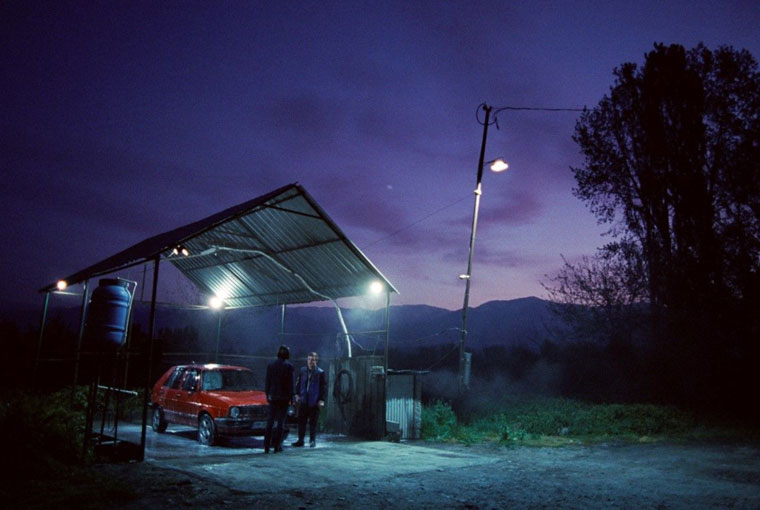
Dea Kulumbegashvili’s April centers on Nina (Ia Sukhitashvili), an obstetrician in rural Georgia who provides illegal abortions while working under the scrutiny of her entourage: her colleague and former lover David (Kakha Kintsurashvili), the head doctor (Merab Ninidze), village rumors, and a faceless figure with hanging skin and a stooped posture. Following a stillbirth at the hospital, Nina becomes the target of an investigation. As she continues to work in the countryside, driving between villages, assisting women in secret, the film unfolds as a sequence of long, unbroken takes: the operating table, the stillborn body, the kitchen-table abortion performed on a deaf-mute teen who was raped by a family member.
April dramatizes how stigma and legal ambiguity can silence women. Abortion in Georgia is legal on request up to 12 weeks of pregnancy and permitted on medical or social grounds up to 22 weeks. Beyond that, it requires approval from a medical committee. In practice, this means that access remains limited – especially in rural areas like Lagodekhi, the director’s hometown region and filming location – due to social pressures, bureaucratic hurdles, and a lack of resources. These barriers pressure women into seeking abortions outside formal structures, which can result in severe legal repercussions such as prosecution under criminal law and imprisonment.
Kulumbegashvili has described her work as addressing these social injustices. In an interview for Sight & Sound, she said that daily shifts in Georgian abortion law, like tightening legislation on IVF and abortion pills, prompted her to record these moments before they vanish: “Every day the Georgian government changes legislation, and it’s worse and worse… In the entire town … there was not even one [abortion] pill available”. That urgency led her to avoid state funding and shoot clandestinely: “I don’t exist as a director in Georgia,” she explained, refusing overt governmental involvement.1 In the debate following the screening of the film in Karlovy Vary, she said that “the purpose of cinema is to prevent people from looking away.”
Historically, artists have frequently taken on tasks of record-keeping, capturing events or conditions that society might otherwise overlook or deny. Post-war Eastern European filmmakers built entire careers on confronting political violence. Karel Kachyňa’s The Ear (Ucho, 1970), Jerzy Skolimowski’s Hands Up! (Ręce do góry, 1967), and Lucian Pintilie’s The Reenactment (Reconstituirea, 1968), to name but a few, each expose systems of surveillance, punishment, and control – bearing witness even under censorship. When lived experiences are excluded from historical documentation, artists function as record-keepers and art becomes one of the few remaining means of preserving what is otherwise denied a public record. In that sense, April steps into a long-standing tradition of cinema that bears witness where institutional records have failed.
April may keep more than one record, however. While the film documents the erosion of reproductive rights in rural Georgia, it also preserves traces of the institutions that enabled its production and circulation. Kulumbegashvili may “not exist” as a filmmaker in Georgia, but her film was supported by European broadcasters such as ARTE and shown at major festivals in Venice, Cannes, and Karlovy Vary. The claim to marginality is real, but it is also framed by systems of validation based elsewhere, a transnational structure that selects which absences become visible.
The long takes, observational distance, and durational pacing in April respond to the formal grammar of European arthouse cinema. The reference points are familiar – Cristian Mungiu’s 4 Months, 3 Weeks, 2 Days (4 luni, 3 săptămâni și 2 zile, 2007) and Michel Haneke’s The Piano Teacher (La Pianiste, 2001) – and may serve as passports to a canon of serious filmmaking, where social gravity and formal rigor function as signs of moral weight.
One scene in April shows Nina engaging in oral sex with a man she picks up on the roadside. The act takes place in a parked car. The camera frames the scene in profile, through the windshield. It does not enter the interior space or offer reaction shots, though the viewer hears the man saying, “I’m tired,” presumably due to erectile difficulty. Nina then takes his hand, places it on her breasts, and stimulates him manually. When she begins to touch herself, the man abruptly hits her head against the steering wheel and window before leaving. The viewer sees only what unfolds in the single, uninterrupted composition.
In Haneke’s Piano Teacher, a similar scene outside a drive-in shows Erika squatting to urinate beside a parked car while a couple is having sex inside. The sound is minimal, and Erika’s action is abrupt and wordless. The couple notices her presence only after the act is complete, at which point Erika looks momentarily frozen and walks away, while the man in the car runs after her screaming insults. While the framing differs from the one in April, both scenes present women in acts of bodily vulnerability and ambiguous sexual dynamics of submission and control. The detachment in each case produces a similar visual economy: stillness, absence of commentary, and a refusal of intimacy with the subject.
April thus renders female desire in ways that are instantly recognizable to audiences trained in the arthouse canon. The reference affirms seriousness and thematic gravity, but it may also limit what the character can be. Nina becomes legible through the film’s echo of a visual and narrative language already familiar from other works. In this sense, April participates in a system of representation where injustice becomes aesthetically legible and perhaps even desirable.
Even the touches of magical realism – such as the faceless figure – can be read through what Stephen Slemon describes as a postcolonial narrative strategy. In his essay “Magical Realism as Postcolonial Discourse,” Slemon argues that magical realism enables competing epistemologies – colonial and indigenous, official and unofficial – to coexist within a single textual frame without being resolved.2 In April, the dreamlike, faceless figure resists clear interpretation. She could represent guilt, fear of ageing, escape, or ancestral presence. But in the context of festival circulation, this ambiguity can risk being flattened into a legible motif of “difference” – a figure whose strangeness cues viewers toward meaning without anchoring it in history. Such moments can slip into a kind of formalized exoticism and become detached from the film’s political stakes.
This reading of April does not cancel the film’s political urgency, but it raises the question of legibility: who must a film speak to in order to be heard? And what must it look like in order to be believed? These questions raise a structural problem: the film’s legibility may bring it closer to a certain type of viewer, but not always closer to the world it is coming from.
- McCabe, K. (2025, April 25). “I don’t exist as a director in Georgia”: Dea Kulumbegashvili on her haunting abortion drama April. Sight and Sound. British Film Institute. https://www.bfi.org.uk/sight-and-sound/interviews/i-dont-exist-director-georgia-dea-kulumbegashvili-her-haunting-abortion-drama-april ↩︎
- Siemon, S. (1995). Magic realism as postcolonial discourse. In L. P. Zamora & W. B. Faris (Eds.), Magical realism: Theory, history, community (pp. 407–426). Duke University Press. https://doi.org/10.1515/9780822397212‑022 ↩︎




Leave a Comment